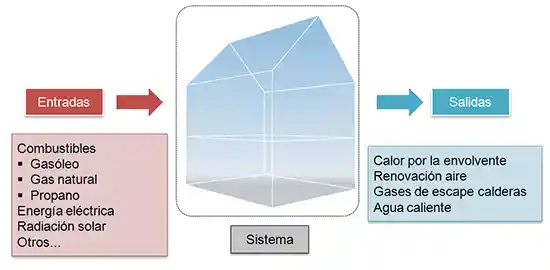We previously explained the laws of thermodynamics, highlighting their importance in the study of the energy consumption of a building.
But how are these laws applied to the energy balance in a building, and what repercussions can we extract from it?
First, let’s consider the building as a thermodynamic system that has energy inputs. These energy inputs are mainly fuels, electrical energy, and solar radiation.
On the other hand, our system will have energy outputs. Mainly, these losses are heat transfer through the building envelope, and energy losses from fluids with a temperature different from that of the environment, such as losses from ventilation air extraction, losses from heat in boiler exhaust gases, or losses of heat from domestic hot water.

Since our system is quasi-stationary, it must be the case that the energy balance is zero, that is, the inputs must equal the outputs. Or in other words, a building’s energy consumption depends solely on its losses, being exactly what is necessary to compensate for them.
This consequence may seem obvious, but it is worth taking a moment to analyze it. In our balance, we have not mentioned, for example, the work done by electrical energy. Let’s imagine our home, with an electrical energy-consuming device, such as an oven, a light bulb, or a motor. These elements will perform their function and, in doing so, will consume electricity. This energy doesn’t “disappear” from the system, but inevitably ends up turning into heat. Thus, the energy used in the oven, light bulb, or motor will end up increasing the temperature of the home.
Some of our readers might wonder why, if all the energy ends up as heat, we try, for example, to replace incandescent lighting of 50W with more efficient ones that achieve the same functionality with 7W. After all, the other 43W will be released into the room as heat, so we will avoid consuming it in fuels in the air conditioning system.
The answer is provided by the second law of thermodynamics, and the concept of exergy. In our example, those 43W had a high exergy and could have been used, for example, in a heat pump to obtain between 170 to 200W of heat.
Therefore, the energy balance of the building, understood as a thermodynamic system, allows us to obtain two fundamental conclusions for any energy saving measure.
- In a building, the energy inputs of the system must equal its losses
- The use of the exergy of the energy inputs of the building must be optimized
For an efficient building, it is necessary for the different installations to operate with the highest efficiency within their own field of action, allowing the designer to allocate the energy consumed by the building exactly where it is needed, and at the precise moment it is required. In this way, energy losses are reduced, achieving the maximum energy performance of the building.
